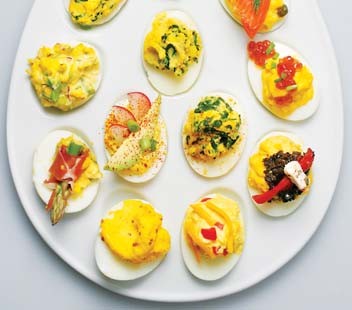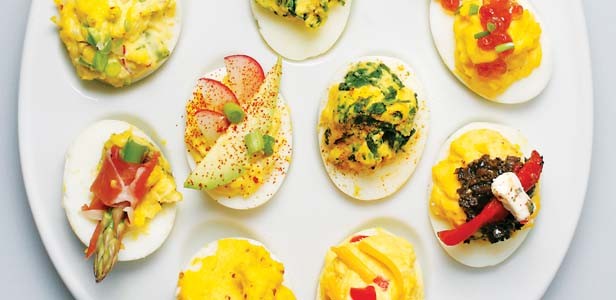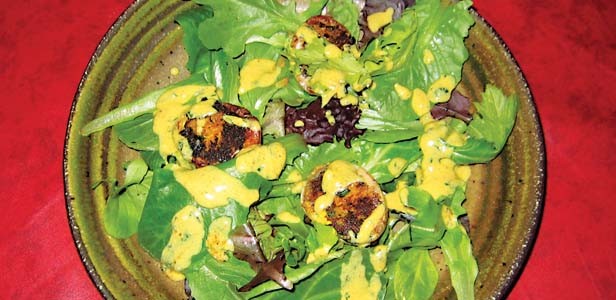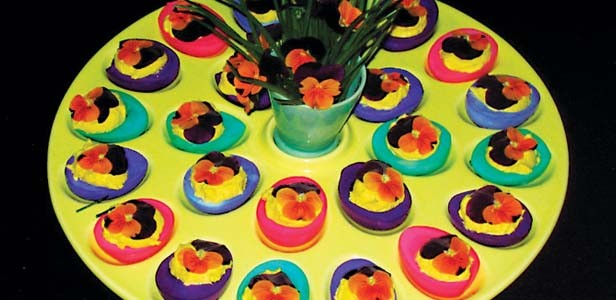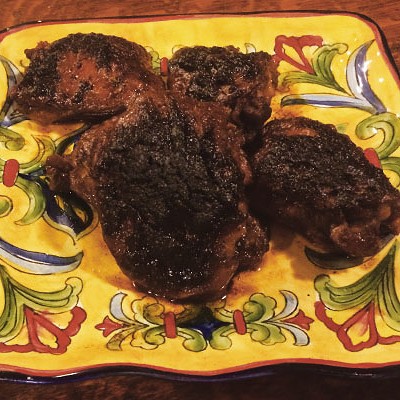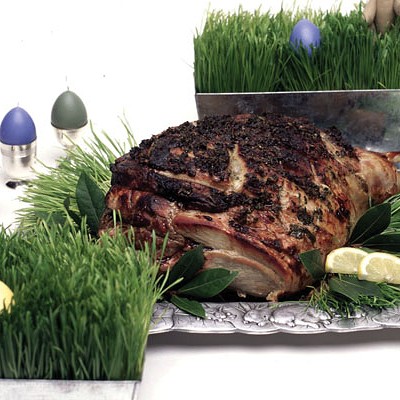I’ve eaten them in Chicago. I’ve eaten them in New York and Boston and St. Louis. I’ve eaten them made with white truffle oil, smoked chilies, avocado, bacon and horseradish, tuna, and black olive tapenade, to name just a few variations.
Deviled eggs – or stuffed eggs, if you’d prefer – used to be primarily the province of picnics and potlucks, or other such homely occasions. But no longer.
I’ve been travelling a lot lately. I always told my children that when they were grown, they either had to live close to home or someplace interesting to visit. They apparently took my words to heart, because one lives in New York, one in Boston, and one in Chicago. In the last month, I’ve visited them all.
Consequently, I’ve eaten in a lot of restaurants. A common thread has been stuffed/deviled eggs on appetizer lists, from a gastro-pub with 40-plus beers on tap, to a Mediterranean restaurant with wonderfully unusual dishes, to a bistro known for its house-made charcuterie (sausages, patés, etc.). They haven’t been on all the restaurants’ menus, of course, but enough of them that it’s clear stuffed eggs have become a trend – yet another comfort food, like macaroni and cheese, that’s delighting even the most sophisticated diners. Even temples of haute cuisine are getting into the act, serving stuffed quail eggs topped with caviar.
Stuffed eggs aren’t just old, they’re ancient – there are records of them going back thousands of years to imperial Rome. The term deviled implies heat and/or spiciness, dating back to a time when the mustard and vinegar used in traditional recipes would have taken most folks to the outer limits of their piquancy tolerance. These days we’re used to eating much spicier and hotter food; calling them “deviled” seems almost inappropriate. Whatever they’re called, whether they’re “gussied up” or traditional, deviled eggs are always popular.
It’s easy to create your own variations of stuffed eggs. Ingredients can be added to your usual recipe, or not. The volume of additions shouldn’t be more than that of the mashed yolks. Mayonnaise is the traditional binder, but sour cream, yogurt, cream or milk can also be used. Ingredients added to the yolks should be minced; larger pieces can be used for garnish. In addition to those above, here are more suggestions:
• Curry powder
• Crabmeat
• Sherry or sherry vinegar
• Wasabi
• Garlic
• Dill, sweet, or bread and butter pickles and/or their juice
• Garlic
• Parmesan
• Shrimp (garnish with a cooked half shrimp)
• Smoked salmon, trout or lox
• Ham
• Roasted red peppers or pimentos
Contact Julianne Glatz at [email protected].
RealCuisine Recipe
Jacques Pépin’s les oefs jeanette
This unusual and delicious recipe for stuffed eggs served warm is adapted from Jacques Pépin’s delightful autobiography, The Apprentice. Pépin says “Our favorite egg recipe was my mother’s creation of stuffed eggs, which I baptized ‘eggs Jeannette.’ To this day, I have never seen a recipe similar to hers, and we still enjoy it often at our house.” He recommends serving them as a first course or for lunch with crusty bread. I like them best served on a bed of baby lettuces. I also added a bit of vinegar to the stuffing.
- 6 jumbo eggs %u2028
- 1 tsp. minced garlic
- 1 tsp. vinegar, preferably sherry vinegar, optional
- 2 T. chopped fresh parsley, preferably flat-leaf%u2028
- 2 to 3 T. whole milk%u2028
- salt and freshly ground black pepper to taste
- 2 T. vegetable oil such as canola or peanut
Dressing:
- 2 to 3 T leftover egg stuffing%u2028
- 4 T. extra-virgin olive oil%u2028
- 1 T. Dijon mustard%u2028
- 1 T. water
- Salt%u2028and freshly ground black pepper to taste
Split the eggs lengthwise. Remove the yolks carefully, put them in a bowl, and add the garlic, parsley, milk, salt and pepper, and vinegar if using. Crush with a fork to create a coarse paste. Spoon the mixture back into the hollows of the egg whites, until just full and smooth with a knife to create a flat surface. Do not mound the filling up as is usual with deviled eggs. Reserve 2 to 3 tablespoons of the filling to use in the dressing.
Mash the reserved filling to a smooth purée in a bowl and whisk in the remaining ingredients for the dressing. Set aside.
Heat the oil in a nonstick skillet, and place the eggs stuffed side down, in the skillet. Cook over medium heat for 2 to 3 minutes, until the eggs are beautifully browned on the stuffed side. Remove, drain and arrange, stuffed side up, on a platter. Drizzle with the dressing and serve immediately.
RealCuisine Recipe
Deviled Easter eggs
- Hard-boiled eggs, shelled
- Mayonnaise
- Dijon mustard
- Cider vinegar
- Ground turmeric, optional
- Salt and freshly ground white pepper to taste
- Red, blue, green and purple food coloring
- Sprigs of dill, parsley or unsprayed edible flowers or flower petals such as violets, nasturtiums, or herb flowers for garnish, optional
Fill 4 large jars such as quart canning jars or bowls about 2/3 full of cold water. Add a color to each container – if you want a brighter or deeper color, add more, for pastel colors, use less. The final color of the eggs will depend on the amount of color you use as well as the length of time the egg whites spend in the solutions. Halve the eggs lengthwise, gently remove the yolks and set aside. Remove any of the yolk that clings to the edges or outside with the corner of a damp paper towel. Discard any torn or broken egg whites, but do add their yolks to the others. Divide the cut egg white halves equally among the containers of colored water. Let stand for at least 1 hour or cover and refrigerate overnight. The color will deepen the longer they stand in the solution.
Purée the yolks in a food processor. Alternatively press them through a food mill or sieve or mash them with a fork. Add mayonnaise, mustard, vinegar, turmeric (this gives the yolks a brighter yellow color) salt, and pepper to taste. The term “deviled” implies a degree of spiciness, however the amounts depend on your personal taste. Do start with just a tablespoon or so of mayonnaise, a teaspoon of mustard, and the same with the vinegar. You want to create a smooth creamy mixture, but one that is not too loose. It’s much easier to add additional seasonings than it is to correct a mixture that is too runny or spicy. Refrigerate the yolk mixture if not using immediately.
Gently remove the whites from the jars and tip out any liquid remaining in the cavities. Turn them upside down on paper towels for 15-30 minutes or until they are completely drained and relatively dry, putting the colors on separate towels so the dye liquids don’t mingle. Place the dyed egg white halves cut side up on a platter large enough to hold them comfortably in one layer. Fill the cavities with the yolk mixture using a portion scoop, two spoons, or a pastry bag fitted with a star tip. Garnish with a sprig of dill or parsley, or an edible flower if desired.
NOTE – The whites may be dyed to fit the season or be a conversation stopper for your favorite sports team. Dye the whites black and add extra turmeric for Halloween or a sports team whose colors are black and gold. Make Illini or Chicago Bears eggs by dying the whites deep blue and adding a tablespoon or so of sweet Hungarian paprika and a drop or two of red food coloring to the yolk mixture.

